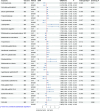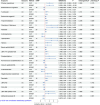Circulating Inflammatory Proteins Mediate the Causal Effect of Gut Microbiota on Inflammatory Bowel Disease: Bayesian and Mediated Mendelian Randomization
- PMID: 40654330
- PMCID: PMC12246389
- DOI: 10.1096/fba.2025-00114
Circulating Inflammatory Proteins Mediate the Causal Effect of Gut Microbiota on Inflammatory Bowel Disease: Bayesian and Mediated Mendelian Randomization
Abstract
Inflammatory bowel disease (IBD), including Crohn's disease (CD) and ulcerative colitis (UC), presents a global public health challenge. Although the relationships between gut microbiota, inflammatory proteins, and IBD are recognized, their causal associations and mediating roles remain unclear. Large-scale genome-wide association study data on 473 gut microbiota, 91 circulating inflammatory proteins, and IBD (including CD and UC) were analyzed. Univariable Mendelian randomization (UVMR), Bayesian Weighted MR (BWMR), mediation MR, and sensitivity analyses were used to explore causal associations and quantify mediating effects. MR results indicate that 24, 20, and 22 gut microbiota exhibit causal effects on IBD (nine protective factors, 15 risk factors), CD (nine protective factors, 11 risk factors) and UC (seven protective factors, 15 risk factors). Three inflammatory proteins (one protective factors, two risk factors) have causal effects on IBD, with five having causal effects on CD (one protective factors, four risk factors) and UC (two protective factors, three risk factors). Mediation analysis reveals that Interleukin-17C levels mediate the causal effects of Acetobacterales and Bifidobacterium on IBD. T-cell surface glycoprotein CD6 isoform levels mediate the causal effect of Faecalibacterium prausnitzii E on CD. Interleukin-17C levels also mediate the causal effects of Acetobacterales on UC and Phocea massiliensis on UC. Gut microbiota and circulating inflammatory proteins play key roles in IBD pathogenesis, with Interleukin-17C and T-cell surface glycoprotein CD6 identified as key intermediates in the causal pathway. These findings provide novel biomarkers and potential therapeutic targets for preventing and treating IBD, CD, and UC.
Keywords: Crohn's disease; Mendelian randomization; circulating inflammatory proteins; gut microbiota; inflammatory bowel disease; ulcerative colitis.
© 2025 The Author(s). FASEB BioAdvances published by The Federation of American Societies for Experimental Biology.
Conflict of interest statement
The authors declare no conflicts of interest.
Figures






Similar articles
-
Mendelian randomization reveals predictive, preventive, and personalized insights into inflammatory bowel disease: the role of gut microbiome and circulating inflammatory proteins.EPMA J. 2024 Nov 12;15(4):693-709. doi: 10.1007/s13167-024-00384-2. eCollection 2024 Dec. EPMA J. 2024. PMID: 39635016
-
Gut microbiota causally affects ulcerative colitis by potential mediation of plasma metabolites: A Mendelian randomization study.Medicine (Baltimore). 2025 Jun 27;104(26):e42791. doi: 10.1097/MD.0000000000042791. Medicine (Baltimore). 2025. PMID: 40587710 Free PMC article.
-
Inflammatory cytokines mediate the gut microbiota-EGPA subtype link: a Mendelian randomization study.Clin Rheumatol. 2025 Jul;44(7):3061-3071. doi: 10.1007/s10067-025-07526-5. Epub 2025 Jun 12. Clin Rheumatol. 2025. PMID: 40500572
-
Interventions for the management of abdominal pain in Crohn's disease and inflammatory bowel disease.Cochrane Database Syst Rev. 2021 Nov 29;11(11):CD013531. doi: 10.1002/14651858.CD013531.pub2. Cochrane Database Syst Rev. 2021. PMID: 34844288 Free PMC article.
-
Vitamin D for the treatment of inflammatory bowel disease.Cochrane Database Syst Rev. 2023 Oct 2;10(10):CD011806. doi: 10.1002/14651858.CD011806.pub2. Cochrane Database Syst Rev. 2023. PMID: 37781953 Free PMC article.
References
-
- Baumgart D. C. and Carding S. R., “Inflammatory Bowel Disease: Cause and Immunobiology,” Lancet 369, no. 9573 (2007): 1627–1640. - PubMed
-
- Lennard‐Jones J., “Classification of Inflammatory Bowel Disease,” Scandinavian Journal of Gastroenterology 24, no. sup170 (1989): 2–6. - PubMed
-
- Marks D. J., Harbord M. W., MacAllister R., et al., “Defective Acute Inflammation in Crohn's Disease: A Clinical Investigation,” Lancet 367, no. 9511 (2006): 668–678. - PubMed
LinkOut - more resources
Full Text Sources
Miscellaneous
